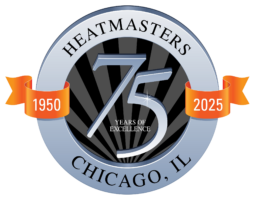On average, people spend 90 percent of their time indoors. Unfortunately, indoor air quality (IAQ) is often two to five times worse than the air outside. And poor indoor air quality has been linked to a variety of respiratory and cardiac diseases. But by installing an indoor air quality system, you can dramatically improve the air quality in your home.
HVAC and indoor air quality go hand in hand. Central heating and cooling systems already circulate air throughout your home. So it only makes sense to lean on these existing systems when trying to improve your home’s air quality. Keep reading for information about some of the indoor air quality systems Heatmasters uses to keep our clients breathing clean air.
Whole-Home Air Purifiers
The most effective whole-home air purifiers rely on electrostatic precipitation. This process involves applying a slight electric charge to airborne particles circulating through the ducts of your heating and air conditioning system. Once charged, the particles are naturally attracted to plates within the collection chamber that have an opposite charge.
These advanced filtration systems are installed into the ducts of your existing HVAC system. And just like the rest of your HVAC system, they require regular maintenance. Because, as the collection plates get dirty, they become less effective at attracting pollutants. But when you call Heatmasters for AC or furnace maintenance in Chicago, our technician can test and clean your indoor air quality system, too.
Whole-Home Humidifiers & Dehumidifiers
The humidity level in your home plays an important role in your overall comfort. Additionally, controlling relative humidity is an effective way to reduce indoor air pollution.
In the summer, highly humid environments can be a breeding ground for mold spores. They also allow allergens and other pollutants to move freely throughout the air circulated by your HVAC system. A whole-home dehumidifier works with your air conditioning system to reduce humidity levels. As a result, you’re AC will run more efficiently, your comfort will increase, and you’ll have an abundance of fresh air to breathe.
Low levels of humidity can be just as big of a problem when it comes to indoor air quality. Low humidity environments dry out our bodies, making it more difficult to combat viruses and respiratory illnesses. By installing a whole-home humidifier, you can minimize the risk of colds and flu affecting your family’s health.
Other Considerations for Improving Indoor Air Quality
Poor air quality means two things: poor health and financial loss. Occupants of buildings with poor indoor air quality may experience asthma or allergy attacks as well as flu-like symptoms. But long-term effects can be even more serious, ranging from respiratory diseases to cancers. To maintain proper IAQ, consider the following:
Source Control
Each indoor air contaminant has a different source such as furniture, building materials, paint, cleaning chemicals, and office equipment. The most effective way to ensure good indoor air quality is to limit the sources of chemical emissions. Find products that have been tested and verified by reputable programs like Green Seal in order to keep a low environmental impact.
Proper Ventilation
Energy efficiency is important, but sometimes when a building is tightly sealed, it reduces ventilation, increasing the accumulation of contaminants in the indoor air. Adequate clean outdoor air needs to be circulated within the indoor environment. There are standards governing the proper application and amount of ventilation necessary to provide acceptable IAQ.
Cleaning and Maintenance
As always, cleaning and maintenance procedure is necessary to keep good IAQ. Low VOC-emitting cleaning products should be used to minimize chemicals released in the air. Remove dust completely rather than just pushing it around, and properly store the cleaning products when not in use. Rooms that house mechanical equipment should not be used to store these materials because it can allow vapors into the supply air stream.
Monitoring
Regular monitoring of the air quality in your building can extend its lifespan and keep occupants healthy and happy. Be sure to:
- Perform functional tests of HVAC equipment
- Perform visual observations and test moisture
- Prepare a list of deficiencies and record the tests you performed
Mold/Moisture Prevention
Mold needs 70 percent humidity present in order to grow, and can also grow as a result of broken pipes or leaks. You should create a mold and moisture prevention program and define who is responsible for responding to any moisture issues down the line. Inspect the building regularly for signs of moisture problems. Establish operating guidelines for HVAC systems, develop and follow a maintenance schedule, and check the operation of temperature control systems monthly. If any problems are found, solve them as quickly and effectively as possible.
Call on Chicago’s Indoor Air Quality Experts
Heatmasters is here to help improve the indoor air quality in your home. Our highly trained technicians can help with everything from indoor air quality testing to IAQ system installs, maintenance and repairs. For some homes, cleaning or replacing your HVAC system’s air filters might suffice. Others might need a more robust indoor air quality solution.
In addition to providing air conditioning repair in Chicago, we can help you decide how to address the air quality in your home. So give us a call today at 773-777-5700 to schedule an indoor air quality consultation. Doing so will quite literally help you breathe easier.
Courtesy of facilitiesnet
http://www.facilitiesnet.com/iaq/article/The-Consequences-Of-Bad-IAQ–10618?source=part#

